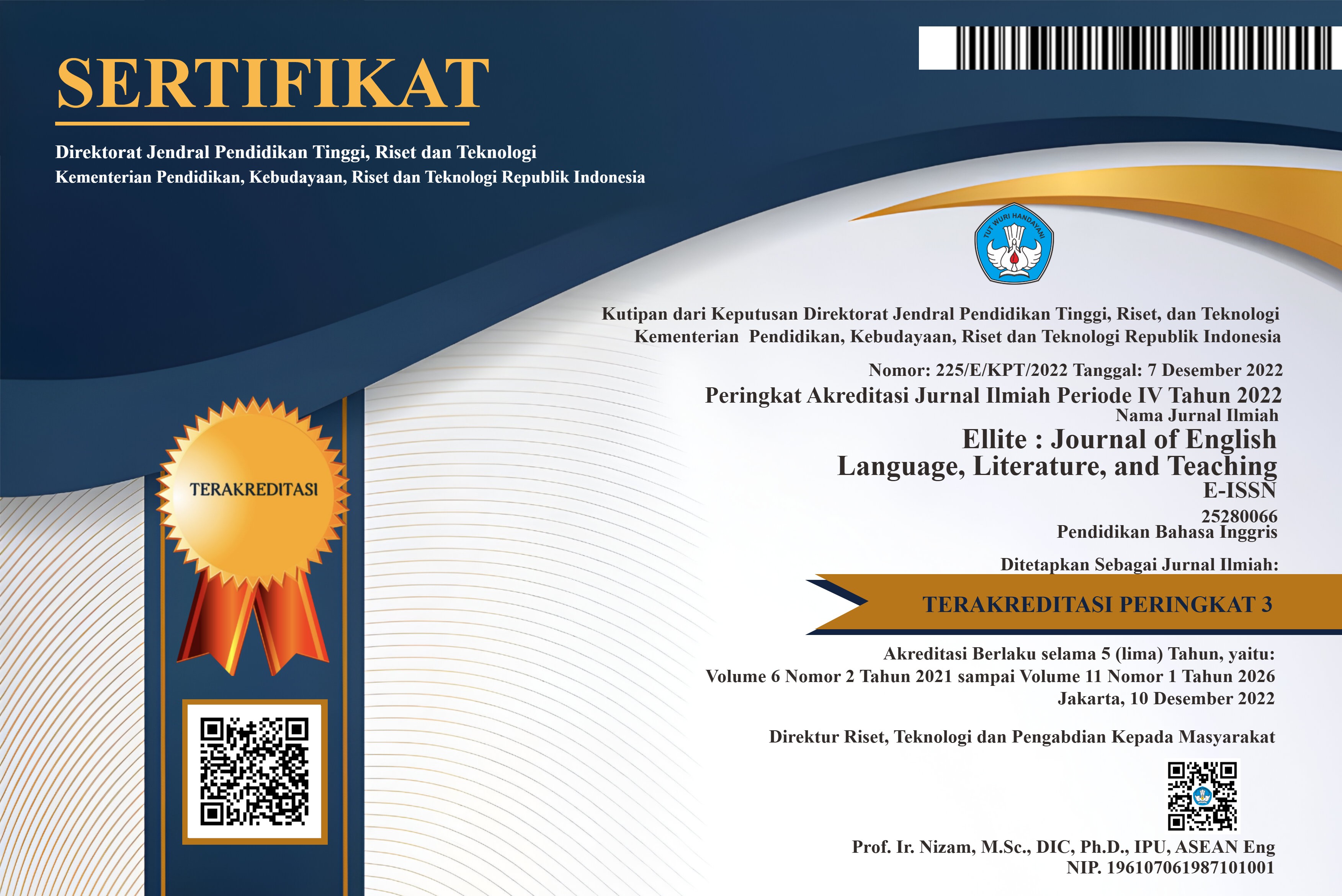The The EFL Students' Experiences with Gamified Learning in Vocational Education: Automotive Students' Perspectives
DOI:
https://doi.org/10.32528/ellite.v10i1.3075Keywords:
EFL students' experience, Gamified learning, Vocational educationAbstract
EFL instruction in vocational education faces challenges in student engagement and technological integration, as many vocational students prioritize major-related studies over English. To enhance engagement, gamification has been introduced as a learning strategy. This study employed a descriptive quantitative survey to explore vocational automotive students’ experiences with gamified learning. A total of 117 automotive students participated, using platforms such as Quizizz, Blooket, and Bamboozle. Data were collected through four Likert-scale questionnaires and analyzed in Microsoft Excel. The research aimed to answer three questions: (1) How does gamification influence students’ engagement in learning English in vocational high school? (2) How effective is gamification in improving students’ learning outcomes and motivation in English lessons? (3) What are students’ overall perceptions of using gamification in English lessons? Findings revealed that gamification significantly improved students' engagement, confidence, motivation, collaboration, and learning outcomes. Students also expressed strong support for its integration into other lessons. The study concludes that gamification is an effective method for enhancing English learning in vocational education. It is recommended that future research adopt a mixed-methods approach to gain deeper insights into vocational students’ experiences with gamified learning.
References
Almusharraf, N. (2023). Incorporation of a game-based approach into the EFL online classrooms: students’ perceptions. Interactive Learning Environments, 31(7), 4440–4453. https://doi.org/10.1080/10494820.2021.1969953
Amo, L., Liao, R., Kishore, R., & Rao, H. R. (2020). Effects of structural and trait competitiveness stimulated by points and leaderboards on user engagement and performance growth: A natural experiment with gamification in an informal learning environment. European Journal of Information Systems, 29(6), 704–730. https://doi.org/10.1080/0960085X.2020.1808540
Bagus Aji Pamungkas, I., & Susilo Adi, S. (2020). STUDENTS’ PERCEPTION ABOUT IMPROVING ENGLISH LISTENING SKILLS USING MOVIES AMONG THE VOCATIONAL HIGH SCHOOL STUDENTS. 2. www.erudio.ub.ac.id
Bicen, H., & Kocakoyun, S. (2018). Perceptions of students for gamification approach: Kahoot as a case study. International Journal of Emerging Technologies in Learning, 13(2), 72–93. https://doi.org/10.3991/ijet.v13i02.7467
Creswell, J. W. (n.d.). RESEARCH DESIGN Qualitative, Quantitative, and mixed methods approaches SECOND EDITION.
Fahada, N., & Asrul, N. (2024). Students Perception of Gamified Learning in EFL Class : Online Quizizz for Engagement and Motivation. Journal Of Education And Teaching Learning (JETL), 6(2), 13–22. https://doi.org/10.51178/jetl.v6i2.1828
Fu, Y., Zhang, L., Zhao, S., & Chen, Y. (2021). Perceptions of Non-English Major College Students on Learning English Vocabulary with Gamified Apps. International Journal of Emerging Technologies in Learning, 16(18), 268–276. https://doi.org/10.3991/ijet.v16i18.24125
Hadi, A. K., Azis, K., & Tamara, D. (2020). SOCIAL MEDIA AND GAMIFICATION ON LEARNING EFFECTIVENESS. EPH - International Journal of Business & Management Science, 6(3), 45–57. https://doi.org/10.53555/eijbms.v6i3.106
Hardianti, H. (2024). Gamification in EFL: Exploring the Use of Gamification Strategies to Enhance Student Motivation and Engagement. https://doi.org/10.37010/int.v5i1
Lofti, T. M., Pratolo, B. W., & Dahlan, U. A. (2021). Students’ Perceptions Toward The Use of Kahoot! Online Game for Learning English Corresponding Email Article’s History Students’ Perceptions Toward the Use of Kahoot! Online Game for Learning English. Ethical Lingua, 8(1), 2021.
Muliyah, P., & Aminatun, D. (2020). Teaching English for Specific Purposes in Vocational High School: Teachers’ Beliefs and Practices. JET (Journal of English Teaching), 6(2), 122–133. https://doi.org/10.33541/jet.v6i2.1756
Nur Patria, A. (2022). International Journal of English Language Studies Vocational English Students’ Perceptions of Learning English Grammar. https://doi.org/10.32996/ijels
Orak, S. D. (2025). EFL Students’ Perceptıon of Gamıfıcatıon-Integrated Englısh Language Educatıon. Pegem Journal of Education and Instruction, 15(1), 143–158. https://doi.org/10.47750/pegegog.15.01.13
Pechenkina, E., Laurence, D., Oates, G., Eldridge, D., & Hunter, D. (2017). Using a gamified mobile app to increase student engagement, retention and academic achievement. International Journal of Educational Technology in Higher Education, 14(1). https://doi.org/10.1186/s41239-017-0069-7
Perdana, P., 1, P., & Priyatmojo, A. S. (2017). Students’ perception toward gamification applied in English language classroom Article Info. Journal of English Language Teaching, 6(1). http://journal.unnes.ac.id/sju/index.php/elt
Purwati, D., Dompu, Y., & Restall, G. C. (n.d.). “Sorry, I Can’t Speak”: English Teachers’ Challenges of Teaching EFL Speaking in an Indonesian Vocational High School Sector 1. In MEXTESOL Journal (Vol. 47, Issue 1).
Rahmani, E. F. (2020). The Benefits of Gamification in the English Learning Context. IJEE (Indonesian Journal of English Education), 7(1), 32–47. https://doi.org/10.15408/ijee.v7i1.17054
Redjeki, I. S., & Muhajir, R. (2021). Gamification in EFL classroom to support teaching and learning in 21st century. JEES (Journal of English Educators Society), 6(1), 68–78. https://doi.org/10.21070/jees.v6i1.882
Rodliyah, R. S. (2018). Vocational school EFL teachers’ practices of integrating ICT into English lessons: Teachers’ voices. Indonesian Journal of Applied Linguistics, 8(2), 418–428. https://doi.org/10.17509/ijal.v8i2.13309
Saleem, A. N., Noori, N. M., & Ozdamli, F. (2022). Gamification Applications in E-learning: A Literature Review. Technology, Knowledge and Learning, 27(1), 139–159. https://doi.org/10.1007/s10758-020-09487-x
Sinnivasagam, P., & Hua, T. K. (2023). Gamification Functionality and Features of Kahoot! in Learning—ESL Teachers and Students’ Perceptions. Open Journal of Social Sciences, 11(02), 404–421. https://doi.org/10.4236/jss.2023.112027
Sirait, N. A., & Kharisma, A. J. (2024). The Student’s Perception on Gamification of Vocabulary Development by Utilizing Quizizz Application. In Teaching and Learning Journal of Mandalika (Vol. 5, Issue 1).
Solikhah, N. A., & Galuhwardani, C. (n.d.). Students’ Perception and Motivation In Learning English Towards The Use of Quizizz For Efl Students. In Bahasa dan Sastra (Vol. 9, Issue 2). Pendidikan. https://e-journal.my.id/onoma
Downloads
Published
Issue
Section
Categories
License
Copyright (c) 2025 Merchandha Sovia Ranti, Putu Dian Danayanti Degeng

This work is licensed under a Creative Commons Attribution 4.0 International License.







